NCERT Solutions for Class 6 Science - Fun With Magnets
Q1. Fill in the blanks in the following:
(i) Artificial magnets are made in different shapes such as ______, ______ and ______.
(ii) The Materials which are attracted towards a magnet are called ______.
(iii) Paper is not a ______ material.
(iv) In the olden days, sailors used to find direction by suspending a piece of ______.
(v) A magnet always has ______ poles.
Ans:
(i) Artificial magnets are made in different shapes such as bar-magnet, cylindrical magnets and horseshoe magnets.

 Cylindrical magnet(ii) The Materials which are attracted towards a magnet are called magnetic materials.
Cylindrical magnet(ii) The Materials which are attracted towards a magnet are called magnetic materials.
(iii) Paper is not a magnetic material.
(iv) In the olden days, sailors used to find direction by suspending a piece of bar magnet.
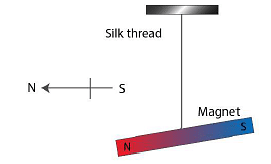
(v) A magnet always has two poles.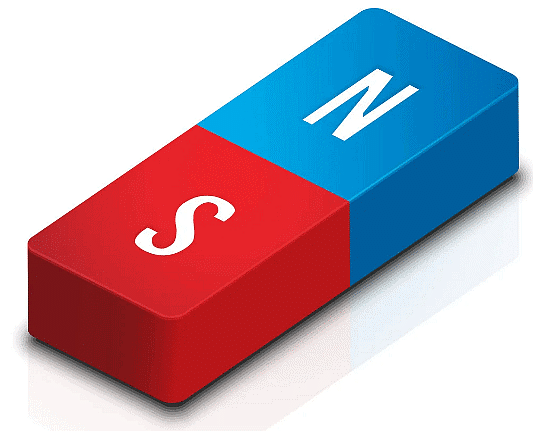 Magnet having two poles (North & South)Q2. State whether the following statements are true or false.
Magnet having two poles (North & South)Q2. State whether the following statements are true or false.
Q3. It was observed that a pencil sharpener gets attracted by both the poles of a magnet although its body is made of plastic. Name a material that might have been used to make some part of it.
Ans: There is a blade in pencil sharpener which is made up of iron. Iron is a magnetic material that is why it is attracted by the poles of magnet.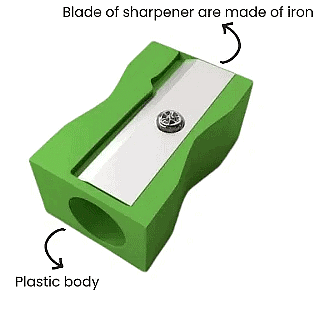
Q4. Column I shows different positions in which one pole of a magnet is placed near that of the other. Column II indicates the resulting action between them for each situation. Fill in the blanks.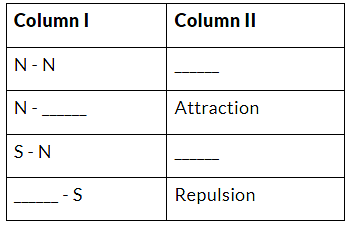
Ans: 
Q5. Write any two properties of a magnet.
Ans: Two properties of a magnet are as follows:
(i) Like magnetic poles repel each other and unlike magnetic poles attract each other.
(ii) A freely suspended magnet always aligns in N-S direction.
Q6. Where are poles of a bar magnet located?
Ans: The poles of bar magnet are located at its two end points. Two Poles
Two Poles
Q7. A bar magnet has no markings to indicate its poles. How would you find out near which end is its north pole located?
Ans:
- The location of the poles of a magnet can be determined by suspending it freely.
- A freely suspended bar magnet always points in the north−south direction.
- The end that points towards the north direction is the north pole of the magnet while the end that points towards the south direction is the south pole of the magnet.
Q8. You are given an iron strip. How will you make it into a magnet?
Ans: An iron strip can be converted into a magnet by the following method:
- Place the iron strip on a table.
- Place one pole of a bar magnet near one end of the iron strip. Move the bar magnet along the length of the iron strip starting from one end to the other end as shown in the following figure.
- Then, lift the magnet and bring the pole to the starting point and move in the same direction as before.
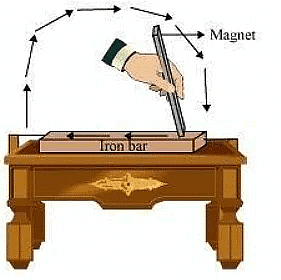
- On repeating this process for at least 30-40 times, the iron strip will become a bar magnet with two poles.
Q9. How is a compass used to find directions?
Ans:
- A compass has a magnetic needle that can rotate freely.
- When a compass is kept at a place, the magnetic needle aligns in north-south direction.
- The red arrow of the compass needle is termed as the north pole and the other end as south pole.
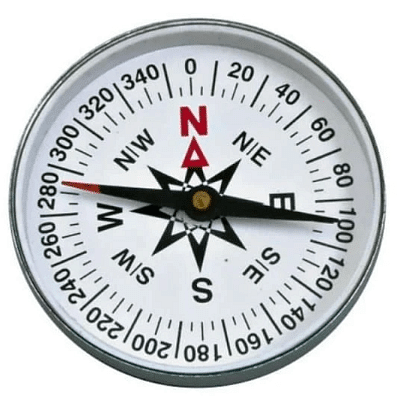 A Compass
A Compass
Q10. A magnet was brought from different directions towards a toy boat that has been floating on water in a tub. The effect observed in each case is stated in Column I. Possible reasons for the observed effects are mentioned in Column II. Match the statements given in Column I with those in Column II.
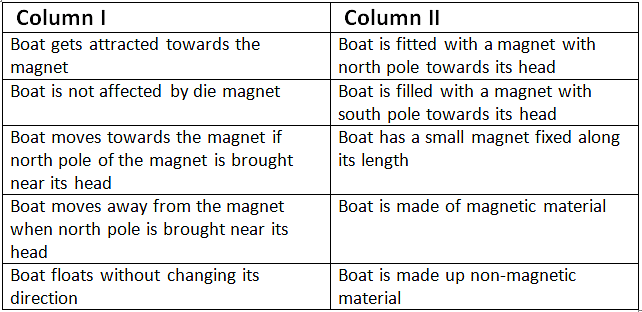 Ans:
Ans:
|
99 videos|261 docs|49 tests
|
FAQs on NCERT Solutions for Class 6 Science - Fun With Magnets
| 1. What is the concept of magnetism? |  |
| 2. How do magnets work? |  |
| 3. What are the different types of magnets? |  |
| 4. How can magnets be used in everyday life? |  |
| 5. How can magnets be used for sorting materials? |  |

|
Explore Courses for Class 6 exam
|

|


















